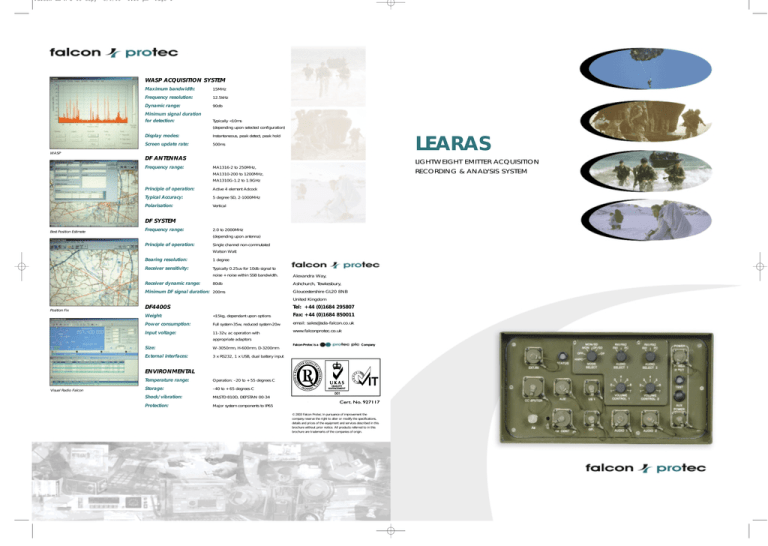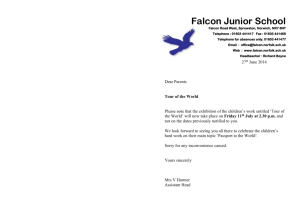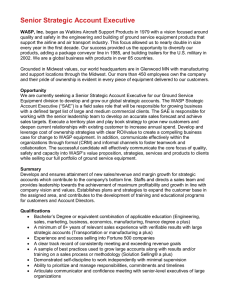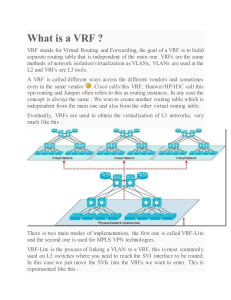WASP ACQUISITION SYSTEM
advertisement

Falcon LE R S 03 copy 3/9/03 1:18 pm Page 1 WASP ACQUISITION SYSTEM Maximum bandwidth: 15MHz Frequency resolution: 12.5kHz Dynamic range: 90db Minimum signal duration for detection: Typically <10ms (depending upon selected configuration) Display modes: Instantaneous, peak detect, peak hold Screen update rate: 500ms LEARAS WASP DF ANTENNAS Frequency range: MA1316-2 to 250MHz, MA1310-200 to 1200MHz, MA1310G-1.2 to 1.9GHz Principle of operation: Active 4 element Adcock Typical Accuracy: 5 degree SD, 2-1000MHz Polarisation: Vertical LIGHTWEIGHT EMITTER ACQUISITION RECORDING & ANALYSIS SYSTEM DF SYSTEM Best Position Estimate Frequency range: 2.0 to 2000MHz (depending upon antenna) Principle of operation: Single channel non-commutated Watson Watt Bearing resolution: 1 degree Receiver sensitivity: Typically 0.25uv for 10db signal to noise + noise within SSB bandwidth. Alexandra Way, Receiver dynamic range: 80db Ashchurch, Tewkesbury, Minimum DF signal duration: 200ms Gloucestershire GL20 8NB United Kingdom Position Fix DF4400S Tel: +44 (0)1684 295807 Weight: <15kg, dependant upon options Fax: +44 (0)1684 850011 Power consumption: Full system-35w, reduced system-20w email: sales@sda-falcon.co.uk Input voltage: 11-32v, ac operation with appropriate adaptors www.falconprotec.co.uk Size: W-3050mm, H-600mm, D-3200mm External interfaces: 3 x RS232, 1 x USB, dual battery input Falcon-Protec is a Company ENVIRONMENTAL Visual Radio Falcon Temperature range: Operation: –20 to + 55 degrees C Storage: –40 to + 65 degrees C Shock/vibration: MILSTD 810D, DEFSTAN 00-34 Protection: Major system components to IP65 © 2003 Falcon Protec. In pursuance of improvement the company reserve the right to alter or modify the specifications, details and prices of the equipment and services described in this brochure without prior notice. All products referred to in this brochure are trademarks of the companies of origin. Falcon LE R S 03 copy 3/9/03 1:18 pm Page 2 LEARAS LIGHTWEIGHT EMITTER ACQUISITION RECORDING & ANALYSIS SYSTEM KNOW WHEN OTHERS ARE MAKING WAVES L Features ■ Portable communications surveillance system EARAS provides a Communications Intelligence gathering system, combining the functionality and flexibility of software based equipment to solve the technical needs of the professional community. This allows the rapidly changing solutions – available commercially Off-The-Shelf – to be provided within a customized system, ensuring that the supplied solution is technically advanced. ■ Operation over the frequency range 2-2000MHz ■ Integral FFT based ‘staring’ panoramic display ■ Powerful PC based applications, including emitter database, audio recorder, data decoder ■ Integrated mapping/graphical information system, including position fixing, and propagation planning tools ■ Integrated interfaces to GPS, communications bearer, Hand off receiver, USB device ■ Integrated dual headset and audio matrix ■ Handheld controller option ■ Lightweight, power efficient design ■ System test facility Supplied as a ruggedised package, optimized for man portable and transportable movement, the equipment is appropriate for operation in harsh environments. System weight is kept to a minimum, using innovative housings and packaging. The standard LEARAS system allows surveillance and direction finding over the frequency range of 2-2000MHz, utilizing three separate antennas. These matched components provide a high accuracy line-of-sight bearing against most communications systems. Any one antenna may be connected individually, allowing very flexible operation. Lightweight antenna mast structures are available (Rolamast), allowing elevation of each antenna, significantly increasing the operational range or line-of-sight of the system. The antennas are also designed for temporary mounting on a vehicle, for tracking or search and rescue missions. The main LEARAS unit is the DF4400S, DF operator and control unit, featuring an embedded CPU. This allows the system to be fully operated via any industry standard laptop computer. The associated hardware interface allows RS232 connections to a variety of external devices, such as NMEA compatible GPS, serial communications devices, additional monitoring receivers, and any USB compatible device. In the monitor mode, the DF4400S has a continuous frequency range of 0.1-2035MHz. Depending upon antenna selection, the DF system will operate over the range 0.5-1900MHz. Reception modes include narrow FM, wide FM, AM, USB, LSB, and CW. Tuning resolution is available down to 10Hz, and allows listen through – providing simultaneous DF and monitor/record of the intercepted signals. Included with the DF4400S is a fully controllable audio matrix, to each of the two headset outputs. The matrix allows for simultaneous twin split receiver working, or monitoring of PC sound output. Essential with any signal acquisition system is an effective panoramic display, allowing a visual indication of RF activity. The DF4400S provides an (optional) FFT generated DSP display, allowing 15MHz of RF bandwidth to be continuously observed. This system, known as WASP, (Wideband Acquisition Signal Processor) allows short duration signals, such as frequency agile emitters, to be reliably identified. OPERATION The LEARAS system provides a number of purpose built software applications, allowing the system’s technical capability to be fully realized. Firstly, the WASP acquisition system allows an operator to easily identify frequencies or ‘signals of interest’ (SOI), and hand over the wanted frequencies to the associated receiving system for further analysis. WASP allows measurement of frequency, bandwidth, amplitude, and time first seen, of SOI. The viewed bandwidth is variable between 15MHz and 25kHz. Once the signal is identified, the frequency may be automatically passed to the main receiver control application – Visual Radio Falcon (VRF). VRF controls all of the associated hardware devices, and provides full control of up to 6 receivers, allowing a flexible acquisition, analysis and monitoring regime. Integral to VRF is a powerful SOI database, allowing all receiver parameters to be automatically logged. Also integral to VRF is an audio recording system, allowing the audio from any of the associated receivers to be recorded for further analysis and transcription. The SOI database is linked to a powerful mapping system – Visual Radio Mapper (VRM). VRF and VRM together allow signals, and their associated bearings and GPS locations, to be passed to VRM and automatically displayed graphically. Should bearings be available from more than one location and sensor, they may be entered into VRM and automatically plotted as a Best Position fix Estimate (BPE). Hand held terminal Static terminal VRF also provides sophisticated mission planning tools, such as point to point visibility and propagation analysis, as well as area coverage displays. CONFIGURATION LEARAS may be supplied in a variety of configurations, from a simple standalone single receiver unit, to a networked multi-receiver system. Additional components and software applications may be easily added, to suit users’ particular individual needs. As a leading systems and equipment manufacturer, Falcon Protec is ideally placed to supply full system design and associated facilities, to meet customer specifications. DF4400S








